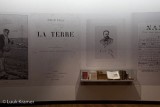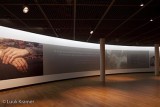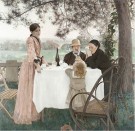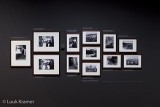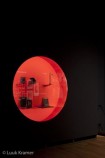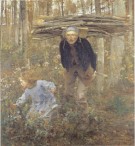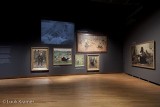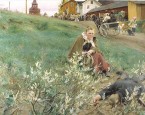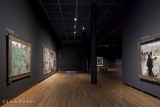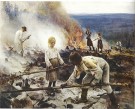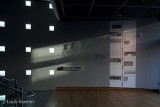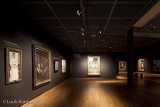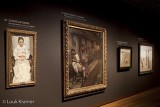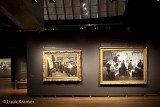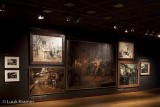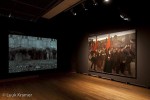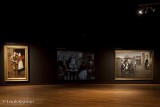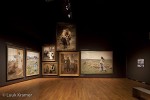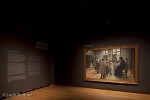The browser will either open the file, download it, or display a dialog.
Illusions of Reality : Naturalist painting, photography and cinema, 1875-1918
Van Gogh Museum, Amsterdam, Holland
August 10, 2010 – January 16, 2011
Illusions of Reality : Naturalist painting, photography and cinema, 1875-1918
Gabriel P. Weisberg, with contributions from Edwin Becker, Maartje de Haan, David Jackson and Willa Z. Silverman.
Amsterdam: Van Gogh Museum, Amsterdam ; Ateneum Art Museum, Finnish National Gallery, Helsinki ; Mercatorfonds, Brussels, 2010. Distributed by D.A.P./Distributed Art Publishers, Inc.
223 pp. with color and B&W illustrations, bibliography, index and exhibition checklist.
34.95 € [Published in Dutch, English, Finnish, French and Swedish.]
ISBN 97890 6153 941 4
In the article "The Map of Art History," which grapples with how the discipline is classified and structured within the field, the author Robert S. Nelson noted that "art history [has] acquired and has been accorded the ability and power to control and judge its borders, to admit or reject people and objects, and to teach and thus transmit values to others."[1] While Nelson's insightful essay is mostly concerned with categorizing art history within unrealistic global borders, his words could also be thought to speak of style categories within the discipline. Many of us who teach nineteenth-century art (or any era of art history) probably still teach through a framework of historical styles, or retain something of that framework thematically, and we were often taught to think of art historical development as a progression of styles. Whether this is a good or bad thing (or if the discussion of "style" is even truthful or necessary any longer) is a matter of opinion; a more interesting exercise might be to examine the styles that we still do and do not teach, and think about those that we continue to ignore over others that we privilege.
Illusions of Reality: Naturalist painting, photography and cinema, 1875-1918, held at the Van Gogh Museum in Amsterdam last fall, was an endeavor meant to insert the somewhat neglected style of Naturalism, along with a lengthy roster of forgotten masters of canvas, brush and camera, back into the academic discussion. The exhibition contained eighty-nine artworks and was guest-curated by Gabriel P. Weisberg, Professor of Art History at the University of Minnesota, and by Edwin Becker of the Van Gogh Museum. [Full disclosure: Dr. Weisberg is the Reviews Editor for Nineteenth-Century Art Worldwide.] There was also a small related presentation called Vincent Van Gogh and Naturalism on the second floor of the Rietveld building at the museum. Naturalism is one of those movements or approaches to subject matter that seems to be afforded less attention in museums and in published scholarship than, let us say, styles from the same period including Impressionism, Neo-Impressionism, Post-Impressionism, Symbolism or even Art Nouveau. With its roots in Realism and its subject the lives of common people, Naturalists artists, according to the introductory wall text, "added a narrative dimension that depicted the contemporary social problems of humanity."[2] While Gustave Courbet, the Naturalists' logical ancestor, raised modest subject matter to the level of historical events, and often removed the individualism of his subjects, the Naturalists kept those modest subjects to a significant but human scale, and used the still-nascent technology of photography to produce detailed images of individual heroes. Realism and Naturalism, however, shared empathy for, and a tendency to show the heroism and nobility of, the working class. In many ways, Naturalism received its legacy from Courbet.
Illusions of Reality is the culmination of more than thirty years of work on Realism and Naturalism by Weisberg, and the exhibition and catalogue joins a significant list of past exhibitions and publications that he has contributed to nineteenth-century art historical studies. These include The Realist Tradition, Painting and Drawing 1830-1900 (1980, with exhibition organized by the Cleveland Museum of Art); The European Realist Tradition (1982, anthology) Beyond Impressionism: the Naturalist Impulse (1992); and Against the Modern: Dagnan-Bouveret and the Transformation of the Academic Tradition (2002, with exhibition organized by the Dahesh Museum of Art). In all of these projects, Weisberg presents a fresh look at Naturalism and/or a specific Naturalist artist and reminds scholars that the study of this period, these artists and this style is essential to the understanding of nineteenth-century art, culture, life and politics. The question, therefore, might be, at a time when the emphasis on the study of specific styles is losing prominence in nineteenth-century scholarship, is Naturalism worth another look? To find out, one must visit the exhibition.
Before reaching the first gallery, the viewer entered Illusions of Reality through a curved corridor and was met with a short excerpt from André Antoine's 1921 film La terre (The Earth), based on the 1887 novel of the same title by Émile Zola (1840-1902) (fig 1). It is actually Zola, and not Courbet, who takes center stage as the founding father of Naturalism in this exhibition, and rightly so: Les Rougon-Marquart, Zola's series of twenty novels that traces the lives, loves, and sins of a fictional working class family in Paris and its environs, was published during the height of the Naturalist movement. At times the series almost seemed to contain the lost narratives for many of the paintings on view. Zola was a Naturalist in literature, and, like many avant-garde styles of the twentieth century, painters often looked to writers and poets for inspiration and direction. La terre was a particularly significant novel in the Les Rougon-Marquart series to Naturalist painters, as it focused on the severe hardships and brutal treatment of the working poor. A very fine exhibition design is employed here at the entrance to the exhibition: three very large details of workers' hands from paintings within the show are juxtaposed on the wall with a loop of Antoine's film, showing a worker's hands caressing a vast lump of silken dirt. The motif of the worker's hand is ubiquitous in Naturalist imagery; the hand, and not the eye, becomes the window to their souls (fig. 2).
Within the exhibition proper, Illusions of Reality was presented on earth-colored walls within dramatically lit, open plan galleries, and was divided into six thematic sections, three on each floor of the special exhibition space at the Van Gogh Museum, where I saw it in November. (The exhibition will travel to the Ateneum Art Museum, Finnish National Gallery, Helsinki in February 2011 and will remain there until May.) These themes included "Naturalism and Photography,"; "Naturalism in Painting,"; "Episodes from Rural and Urban Life,"; "The Innocence of Youth,"; "Industrialization Takes Command," and "Representing Belief." The first of these began with the works of Jules-Alexis Muenier (1863-1942), a painter who used photography to develop his hyper-realistic painting Beautiful Days (1889) (fig. 3). Many other Naturalists, including the English photographer Peter Henry Emerson (1856-1936) and the French painter Pascal-Adolphe-Jean Dagnan-Bouveret (1852-1929), whose works were also featured in the exhibition, took photographs and used photography as source material for their images as well. Twelve of Muenier's photographs were exhibited next to the finished painting, and except for the child in the foreground, who seemed to give him the most cause for thought and change, Muenier remained quite faithful to his photographic studies (fig. 4). (Another exception was in the depiction of the face of his wife, whose age in the painting seems to have been turned back twenty years from the age she seems to have really been in the photographs). Muenier's own cameras and camera equipment were beautifully presented in a lens-shaped display, painted with a red background reminiscent of the color of light in a darkroom, and tucked into the exhibition wall (fig. 5). Muenier's camera lucida, used to transfer photographic images onto his canvases, was displayed a little bit too high to be viewed properly by a short person like myself, but it was still instructive to see his personal equipment here, emphasizing the large extent to which he used photography to create a painted picture. While Emerson supported, and then reversed his position on, photography as an art form, his very discussion of the subject, and the use of photography by Naturalist painters like Muenier, worked to catapult this debate into the next century.
"Naturalism in Painting," the second theme of the exhibition, focused on large-scale paintings by some of the more well-known artists of the movement. The true leader of Naturalism in painting was without doubt Jules Bastien-Lepage (1848-1884), an artist who had barely made his mark on the contemporary scene before succumbing to stomach cancer just as the movement was gaining vigor. An 1885 posthumous retrospective of Bastien-Lepage's work helped to establish the most characteristic themes of Naturalism: rural life, as seen in his image The Wood Gatherer (also called Le Père Jacques, 1881, fig. 6); youth and the young worker, as in his Nothing Doing (Pas mèche) also from 1881; and religion and belief, as in his most famous work, Joan of Arc Listening to the Voices (1879, Metropolitan Museum of Art, New York, not in exhibition). One did not need the Metropolitan's Joan of Arc in this exhibition; The Wood Gatherer, with its similarly lush foliage and delicate swathes of periwinkle and golden brown, exhibits all of the refinements of the better-known painting. The message of The Wood Gatherer is actually more universal: while youth picks flowers, old age continues to bear a heavy burden, here shown as a large bundle of kindling. An additional film clip of Antoine's La terre was shown directly on the exhibition wall right above Haymakers (1890) by the Hungarian artist István Csók (1865-1961). In both, and in Bastien-Lepage's Haymaking (1878, Musée d’Orsay, Paris), which was not in the exhibition but was reproduced in the small exhibition brochure provided to visitors for free at the start of the show, workers rest or sleep in a mound of hay (fig. 7). The theme continues in Homeless (Sans asile, 1883), by Fernand Pelez (1843-1913), in which a small boy and some of his siblings sleep on the street with their heads resting on potato sacks or on the back of their mother. The suggestion that the earth is both the cradle and the grave of the worker abounds in Naturalist imagery, such as in these works and in others throughout the exhibition.
Many of the artworks shown within the third theme of Illusions of Reality, entitled "Episodes from Rural and Urban Life," act to remind the viewer of nineteenth-century social injustices and ills such as poor working conditions, child labor, severe urban poverty and alcoholism. The Mora Fair (1892) by the Swede Anders Zorn (1860-1920) provides a glimpse into an episode of public drunkenness, the subject of which was also at the core of Zola's Les Rougon-Marquart (fig. 8). A telling juxtaposition is found here as well in the installation of Pelez's wonderful and immense Grimaces and Misery (Les Saltimbanques, 1888) across from The Luxembourg Gardens, Paris (1887) by Albert Edelfelt (1854-1905). In the former, a small drummer boy weeps at the far left, seemingly from fatigue and hunger; as one young girl looks upon him with pity, another folds her arms in front of her with a face full of annoyance and disdain. Everyone else in Pelez's circus sideshow plays along, but none of the characters seem completely engaged in what they are doing. They have the facial expressions of people going through the motions of something they despise doing, but are resigned to do. In the latter painting by Edelfelt, Parisian children are adored and fawned upon, and play and bask in a sunny afternoon that seems made for them alone. The brilliant pairing of these two works almost exactly opposite each other drives home a truth that stings: not all children experience childhood equally (fig. 9).
Edelfelt, however, was not blind to the troubles that plague childhood. His austere image Conveying the Child's Coffin (1879), is a tour-de-force of Naturalist painting (fig. 10). The child in the foreground, who was spared the fate of the child in the coffin next to her, glances longingly at her reflection in the water, while the mother figure similarly glances out towards the horizon, searching for something lost. This large canvas, with its blue tones that accurately set the mood, and its amazingly modern brushwork in the water and the background passages, won Edelfelt a third class medal at the Salon of 1880, making him the first Finnish artist to ever win a medal at the Salon. Such truths about childhood poverty and death are rarely, if ever, dealt with by painters of other movements during the same period; children reign as the adored, carefree darlings of Impressionist art, for example. The theme of the tragedy of childhood, however, continues in many of the Naturalist paintings shown. This subject is in none of them bleaker and more truly startling than in a painting by Edelfelt's countryman, Eero Järnefelt, entitled Under the Yoke (Burning the Brushwood), painted in 1893. The troubled, piercing stare of Johanna Kokkonen, the young model of Järenfelt's work, haunts the viewer long after they have moved on (fig. 11).
These issues of childhood experience are carried up to the second half of the exhibition, and continue in the section entitled "The Innocence of Youth" (fig. 12). After passing a timeline affixed to the wall near the staircase, which focused on major historical events, mostly from France and England, from 1850 to 1920, the viewer entered the galleries on the second floor (fig. 13). The section began with the familiar painting The Sick Girl (1880-81) by Norwegian artist Christian Krohg (1852-1925). As David Jackson superbly describes in the catalogue for the exhibition, Krohg's painting from experience "rather than in the tradition of a popular genre which evoked pathos but tended to hint at recovery, Krohg offended contemporary sensibilities by his insistence on the child's deathly pallor and dark-rimmed eyes, and the fact that she occupies the whole picture space, affording the viewer no relief from this encounter with the death room."[3] One could add that the sick girl's weak grasp of a dying pink rose completes the effect. Henry Herbert La Thangue's The Man with a Scythe (c.1896) depicts another young girl, similarly seated as Krohg's sick girl, but here slumped and lifeless, with her eyes closed. La Thangue adds a narrative where Krohg does not; in La Thangue's painting, as the caregiver looks at the unresponsive girl with growing concern, she has not yet noticed the man with the scythe, a personification of Death, entering the courtyard. The prevalence of childhood illness and the scourge of the "white plague" – tuberculosis – that wreaked havoc across Europe throughout the nineteenth century was a central theme in Naturalism, one difficult to accept, but nonetheless common in daily life (fig. 14).
As little girls drop dead in these paintings like flies in September, little boys, by contrast, were shown wrestling, skipping stones, going to school or working in apprenticeships. Advances in education and the re-evaluation of childhood as a time for learning and cognitive development, at least for boys, was prominent during the period and was also explored by the Naturalists, as evidenced by Albert Bettanier's The Geography Lesson: The Black Stain (1887) and Jean Geoffroy's The Drawing Lesson in a Primary School (1898). Geoffroy's young subjects behave like little men at a miniscule version of the École des beaux-arts; they sketch from plaster casts, take instruction from their teacher, and admire each others' works. Commissioned by the French Education Ministry and exhibited at the 1900 Universal Exhibition in Paris, Geoffroy's full series of six images of public schooling served to promoted education of children for the public good of society. Bettanier's painting of young men learning about the loss of Alsace-Lorraine to the Germans added an element of nationalism to Naturalism that was also common to the style (fig. 15).
The subjects of anarchy, labor strikes and political unrest that occurred internationally are the focus of the fifth section of the exhibition, entitled "Industrialization Takes Command." The theme of education and training logically continues here, and depictions of well-behaved grinders, laminators, metal casters, printers and wood carvers abound (fig. 16). Even the American artist Thomas Anshutz (1851-1912) is represented with his The Ironworkers' Noontime (1880), whose cut-nail makers are shown taking a break from their labor, but who also seem prepared for a fight to break out at any moment. Yet the more powerful images of social unrest are depicted in an excerpt of a labor strike from French film director Albert Capellani's 1913 work Germinal, based on Zola's novel published in 1885, and in Jules Adler's painting The Strike at Le Creusot (1899). These images, whether in film, painting or literature, reflect the socialist principles of Zola's novel, the accuracy of the workers' new position in society, and their desire to obtain appropriate working conditions and a living wage (fig. 17). The large size of many of the paintings in this part of the exhibition influenced the sense of the importance of the theme of labor issues. While Adler's sizeable painting shows a strike already in progress, with workers unified together, hand-in-hand and arms entwined, the German artist Hubert von Herkomer (1849-1914) illustrates the individual anger and turmoil of the disgruntled worker in his painting On Strike (1891). Here, a life-sized image of a family is illustrated standing tightly in a doorway, the husband made angry, the wife made despondent and the children made miserable (even the infant seems to comprehend the social unfairness that confronts them) by the loss of income that they will undoubtedly face. Capellani's film excerpt is flanked by Herkomer's unfortunate family on the left and by another family in trouble, depicted in The Interrogation (1897) on the right by the Hungarian artist László Pataky (1857-1912, fig. 18). A reality of social activism is the possibility of retaliation by the powers that one fights against. Pataky's painting shows the embarrassing consequences of anarchy, as the wife and child stand outside an official office, humiliated in public, as the male head of the household is questioned within about his political activities.
The exhibition, however, closes with images of hope and renewal through religion. "Representing Belief" had the least number of works displayed and no related cinematic presentations, but operated to show images of holy figures with which the poor and working classes could identify and find solace (fig. 19). Christ and saintly figures are humanized in Naturalist paintings such as in Let the Little Children Come to Me (1884) by the German painter Fritz von Uhde (1848-1911), which portrays Christ in simple garb and without any special glow of light or halo, comforting shy peasant children in a small, rustic interior (fig. 20). Similarly, Saint Geneviève (c.1887) by the American Naturalist Charles Sprague Pearce (1851-1914) would have made an excellent companion piece for Bastien-Lepage's Joan of Arc. Pearce, who was living in Auvers-sur-Oise at the time he created Saint Geneviève, had been inspired by the embellished nobility of French peasants in the works of Aimé Millet, Jules Breton, Bastien-Lepage, and Léon Lhermitte.[4] The exhibition closes with Pearce's The Return of the Flock (also called the Shepherdess, c. 1885-1890), which reiterates the noble peasant theme with an added reference to a religious parable, and an installation photograph of the Pan-American exhibition of 1901, showing Pearce's painting as exhibited there. While it was admirable to close the exhibition with a suggestion of optimism for the future of the unfortunates who passed before the viewer's eyes, some things seemed missing here, most notably a film excerpt from Ferdinand Zecca's The Life and the Passion of the Lord Jesus Christ (1905), which was a very early cinematic staging of the life of Christ; the film is briefly discussed in the catalogue for the exhibition and a film still of the Veronica and Christ scene is reproduced in Weisberg's catalogue essay on Naturalist cinema, but an excerpt of the film was not included in the presentation.[5] It is possible that a film about Jesus might not be easily considered Naturalist, but it may have ended the exhibition with greater impact than the smallish photograph of the Pan-American Exhibition.
When film excerpts were included in Illusions of Reality, they were projected directly onto the walls of the exhibit throughout (seen in the illustrations here), rather than in separate screening rooms, as is more typical in shows that exhibit such excerpts. This was a quite innovative and fresh way to install films. Something of the context certainly would have been lost if the films had been separated from the paintings, or if they had all been screened at the end of the exhibition in some dark cavern with no seating. This organization also gave the films a status equal to the paintings. The Salon-style hanging of the paintings was also engaging. Some paintings (and films) were grouped together as they might have been in the period, but these groupings were not overly dense or tedious. Also, the small brochure that was made available to visitors at the start of the exhibition contained the material for what would have been all of the wall labels in a more typical exhibition. Since there were no actual wall labels (names of artists, titles of artworks, dates and current locations were affixed to the walls with press-on adhesive letters), the result was a clean, streamlined presentation. One could still have all the benefits of additional information on each object from the small brochure, which was tiny enough to fit in a pants or jacket pocket. The full catalogue was available for viewing at the end of the exhibit. The exhibition was accompanied by a fully-illustrated catalogue, edited by Weisberg, that contained five essays by him dealing with the diverse topics handled within the exhibition (cinema, photography as an illusionary aid, Naturalist themes, and critical reception of the artworks); one essay by David Jackson, quoted above, on Russia and the Nordic contributions to Naturalism; one essay concerning Naturalism and Dutch painting by Maartje de Haan; and one essay entitled "Staging Naturalism," by Willa Z. Silverman, concerning theater and film productions with Naturalist subjects. All of these were engaging, readable, fully illustrated essays with works from the exhibition and with works that were not, or could not, be included. My only grievance about the connection between the catalogue and the exhibition is that the catalogue is superior to the exhibition in dealing with issues of nationality and nationhood. For example, nowhere in the small brochure or on the walls next to each artist's name could the viewer find the nationality of any artist; their nationalities were not always obvious by their last name or the current location of their artwork. Yet the catalogue contains whole essays about Naturalism's impact within different countries, and the cross-cultural influences between artists. The emphasis on nationality also appears in Weisberg's earlier publication Beyond Impressionism: the Naturalist Impulse; in fact nationality is its organizing factor. While the lack of information on the artist's nationalities within the exhibition acts positively to create a sense of Naturalism's universality, it also lessened the impact of the style's reach and the fact that these works came from many different corners of the world.
As a specialist in sculpture, I found the absence of the plastic arts from the exhibition palpable at the time I viewed the exhibition. Sculptures by Constantin Meunier (1831-1905) and Aimé-Jules Dalou (1838-1902), whose oeuvres abound with Naturalist themes, would have fit nicely into the context of the exhibition. In retrospect, however, the connections made between the two-dimensional media of painting, photography, and film were so substantial and strongly presented that it may not have added much to further the discussion of Naturalism to have sculpture represented in the show. Also, dense bronzes and fragile plasters are difficult to borrow and expensive to transport, and their inclusion may have required the omission of some of the paintings in the exhibition, and that would have spoiled the final result, which was excellent. There weren't any works present that did not belong in the show. As someone who studies the contribution of women artists, I lamented the omission of art by women in the exhibition. However, in defense of the curators, not a whole lot of women artists came to mind whose work might fit into the stylistic category of Naturalism. The Ukranian-French artist, Marie Bashkirtseff (1858-1884), Polish artist Anna Bilińska-Bohdanowicz (1857-1893), and the American painter Elizabeth Gardner (1837-1922) created works that might be considered Naturalist, and they might have been possible additions, but these artists did not immediately come to mind and, like sculpture, their work may not have necessarily expanded the thesis of the exhibition.
Illusions of Reality ultimately achieved some very important objectives. The curators wisely note in the catalogue's introduction that it is time art historians accept styles previously ignored and see the contributions of these styles to the modern world. "Critics now, as then," they note, "are reluctant to openly discuss or even advocate popular and social art in which any form of individual self-expression or abstraction was suppressed or the emphasis placed on the unfolding of the narrative and easy accessibility for a large public audience."[6] A certain elitist stance against "popular and social art" remains in our field and the exhibition attempted to eliminate it. Biases towards certain geopolitical locations also exist, as noted in Nelson's essay with which I began. We tend to imagine, still, that France gave rise to all "important" styles and movements of the late nineteenth-century; Nelson calls the attention to such "imagined communities" a "distortion of historical geography."[7] While I would have liked more attention to be drawn to nationhood and national identity within the exhibition, the wide global reach of Naturalism was still there, present in the works themselves, and this presence helped to dispel the myth that French artists were the only creators and producers of avant-garde, socially conscious art. Illusions of Reality expanded the discussion and scholarship of Naturalism with its inclusion, both in the exhibition and the catalogue, of film, literature, and photography, and the interrelationship between these three art forms. This exhibition strongly demonstrated that Naturalism is worth our attention because it had a wide influence well past France's borders; it was a vision of contemporary life rarely noticed; it was an avant-garde style in which the use of contemporary literature and photography greatly informed painters and, a bit later, the earliest filmmakers; and, for its time, it was courageous and modern. One could argue that from the seeds sown by Naturalism, the later American styles of the Ashcan School, Social realism and Regionalism were able to grow. Few artists at the fin-de-siècle, apart from the Naturalists, continued to speak for the poor and working class and exposed their plight without romanticizing it. While Impressionism imitated leisure and affluent life for the wealthy, Naturalism reflected for the common man and woman their own trials, their own tribulations and, ultimately, their own hope for salvation.
Caterina Y. Pierre, Ph.D.
caterinapierre[at]yahoo.com or caterina.pierre[at]kbcc.cuny.edu
Links:
Van Gogh Museum, Amsterdam
http://www.vangoghmuseum.nl/
Ateneum Art Museum, Finnish National Gallery
http://www.ateneum.fi/en/
I wish to express my gratitude to Edwin Becker and Marlieke Schoen, of the Van Gogh Museum, Amsterdam, for providing the installation photographic views for this review.
[1] Robert S. Nelson, "The Map of Art History." Art Bulletin 79:1 (Mar., 1997): 28.
[2] Introductory wall text and exhibition brochure for Illusions of Reality: Naturalist painting, photography and cinema 1875-1918.
[3] David Jackson, "Natural North: Russia and the Nordic Countries," in Illusions of Reality: Naturalist painting, photography and cinema 1875-1918 (Van Gogh Museum, Amsterdam; Ateneum Art Museum, Helsinki; Mercatorfonds, Brussels, 2010), 116.
[4] Mary Lublin, A Rare Elegance: The Paintings of Charles Sprague Pierce (1851-1914) (New York: Jordan-Volpe Gallery, 1993), 35.
[5] Gabriel P. Weisberg, "The Early Naturalist Cinema: Mass Media and Painting Traditions," in Illusions of Reality: Naturalist painting, photography and cinema 1875-1918 (Van Gogh Museum, Amsterdam; Ateneum Art Museum, Helsinki; Mercatorfonds, Brussels, 2010), 142
[6] Edwin Becker and Gabriel P. Weisberg, "Introducing Naturalism," in Illusions of Reality: Naturalist painting, photography and cinema 1875-1918 (Van Gogh Museum, Amsterdam; Ateneum Art Museum, Helsinki; Mercatorfonds, Brussels, 2010), 13.
[7] Robert S. Nelson, "The Map of Art History." Art Bulletin 79:1 (Mar., 1997): 32.


